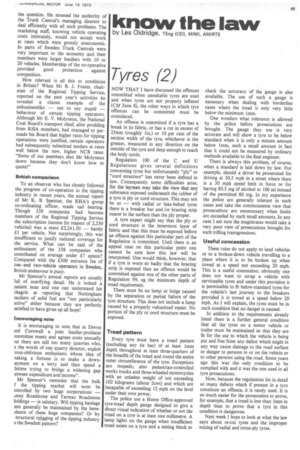know the law
Page 91

If you've noticed an error in this article please click here to report it so we can fix it.
by Les Oldridge, TEng (CEO, MIMI, AM1RTE
Tyres (2)
NOW THAT I have discussed the offences committed when unsuitable tyres are used and when tyres are not properly inflated (CM June 8), the other ways in which tyre offences can be committed must be considered.
An offence is committed if a tyre has a break in its fabric, or has a cut in excess of 25mm (roughly lin.) or 10 per cent of the section width of the tyre, whichever is the greater, measured in any direction on the outside of the tyre and deep enough to reach the body cords.
Regulation 100 of the C and U Regulations gives several definitions concerning tyres but unfortunately "ply" or "cord structure" has never been defined in law. Consequently some difficulties arise, for the layman may take the view that any substance exposed underneath the rubber of a tyre is ply or cord structure. This may not be so — with radial or bias-belted tyres there is a breaker bar and/or bracing strip nearer to the surface than the ply proper.
A tyre expert might say that the ply or cord structure is the innermost layer of fabric and that this must be exposed before an offence against this particular part of the Regulation is committed. Until there is an appeal case on this particular point one cannot be sure how this law will be interpreted. One would think, however, that if a tyre is worn so badly that the bracing strip is exposed then an offence would be committed against one of the other parts of Regulation 99, eg the minimum depth of tread requirement.
There must be no lump or bulge caused by the separation or partial failure of the tyre structure. This does not include a lump caused by a properly vulcanized repair. No portion of the ply or cord structure must be exposed.
Tread pattern
Every tyre must have a tread pattern (excluding any tie bar) of at least 1mm depth throughout at least three-quarters of the breadth of the tread and round the entire outer circumference of the tyre. Exceptions are mopeds; also pedestrian-controlled works trucks and three-wheeled motorcycles with an unladen weight of not exceeding 102 kilograms (about 2cwt) and which are incapable of exceeding 12 mph on the level under their own power.
The police use a Home Office-approved tyre-tread depth gauge designed to give a direct visual indication of whether or not the tread on a tyre is at least one millimetre. A lamp lights on the gauge when insufficient tread exists on a tyre and a setting block to check the accuracy of the gauge is also available. The use of such a gauge is necessary when dealing with borderline cases where the tread is only very little below the minimum lmm.
One wonders what tolerance is allowed by the police before prosecutions are brought. The gauge they use is very accurate and will show a tyre to be below standard when it is only a minute amount below lmm, such a small amount in fact that it could not be measured by ordinary methods available to the fleet engineer.
There is always this problem, of course, when a standard is laid down by law. For example, should a driver be prosecuted for driving at 30.5 mph in a street where there is a 30 mph speed limit in force or for having 80.5 mg of alcohol in 100 ml instead of the permitted 80 mg. In my experience the police are generally tolerant in such cases and take the commonsense view that prosecutions are unnecessary when limits are exceeded by such small amounts. In any case I am sure the magistrates would take a very poor view of prosecutions brought for such trifling transgressions.
Useful concession
These rules do not apply to land vehicles or to a broken-down vehicle travelling to a place where it is to be broken up when towed at a speed not exceeding 20 mph. This is a useful concession; obviously one does not want to scrap a vehicle with serviceable tyres and under this provision it is permissible to fit below-standard tyres for the vehicle's last journey to the breakers provided it is towed at a speed below 20 mph. As I will explain, the tyres must be in such condition that no danger is caused.
In addition to the requirements already listed there is a further general condition that all the tyres on a motor vehicle or trailer must be maintained so that they are fit for the use to which the vehicle is being put and free from any defect which might in any way cause damage to the road surface or danger to persons in or on the vehicle or to other persons using the road. Some years ago this was the only condition to be complied with and it was the one used in all tyre prosecutions.
Now, because the regulations list in detail so many defects which if present in a tyre constitute an offence, it is rarely used. It is so much easier for the prosecution to prove, for example, that a tread is less than lmm in depth than to prove that a tyre in this condition is dangerous.
Next week I hope to look at what the law says about re-cut tyres and the improper mixing of radial and cross-ply tyres.












































































































































